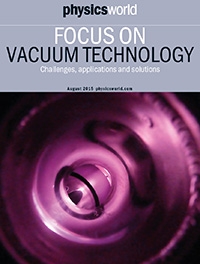By Hamish Johnston

Fusion power, redefining the kilogram and mimicking the Martian surface are three exciting areas of science and technology that are benefiting from the latest vacuum equipment. In our latest Focus on Vacuum Technology, which you can read free of charge, Christian Day of the Karlsruhe Institute of Technology in Germany explains how new pumping technologies will be crucial to the successful operation of future fusion power plants. “Proving the power of fusion” focuses on the extraordinary vacuum challenges facing the designers of the planned DEMO reactor, which is expected to generate 2 GW of electrical power by the mid-2030s.
Today, the kilogram is defined in terms of a cylinder of a platinum–iridium alloy that was made in the 1880s. Metrology has moved on since then and all of the other SI base units are now defined in terms of fundamental constants. In “The kilogram’s constant struggle”, Stuart Davidson and Ian Robinson of the National Physical Laboratory in Teddington, UK, explain how vacuum technology is playing a crucial role in the development of new ways of defining the kilogram, one of which will ultimately be chosen as the new global standard.
A kilogram is still a kilogram on Mars, but conditions on the surface of Red Planet are very different from Earth – and this poses unique challenges to designers of Mars landers. Vacuum technology has come the rescue in the form of MARTE at the Spanish Astrobiology Centre in Madrid, which simulates the low atmospheric pressure, cold and even the dust storms on Mars, as the centre’s Jesús Sobrado, Juan Manuel Manchado and Jose Angel Martín-Gago explain in “Mimicking the Martian surface”.
Also in the focus issue, Matthias Wiemer of Pfeiffer Vacuum in Germany looks back on some of the milestones achieved by the firm as “Pfeiffer Vacuum turns 125”. Sunil Patel of the Rutherford Appleton Laboratory in the UK explains how the ISIS neutron source is benefiting from a major vacuum upgrade in “Neutrons fit for the future, and in “Vacuum aid to nano exploration”, Paul Evans of the University of Wisconsin-Madison reveals how bespoke vacuum sample environments at synchrotron X-ray facilities are improving the synthesis of new materials.
The 2015 Focus on Vacuum Technology also contains a round-up of the latest vacuum news and an events diary.
Guidelines
Show/hide formatting guidelines
this text was deletedwhere people live in harmony with nature and animals</q>
Some text